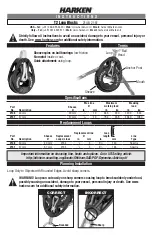
23
Kice Industries, Inc.
MAN-100-000-008
110722
Maintenance and Service Continued
HELPFUL HINT:
Working one side of airlock at a time helps keep the rotor centered. If one bearing is
locked at a time, rotor shifting will be limited. If both bearings are loosened rotor will shift from side to
side.
NOTICE:
Imperative to keep all sealing components clean through the duration of replacement.
VJO BEARING REMOVAL / REPLACEMENT
COMMON BEARING INSTALLATION MISTAKES
Common Mistakes
Problem
Solution
Not keeping
ALL
bearing and sealing
surfaces clean during installation.
→
Bearing and rotor seizure.
→
Check for grease and bearing contamination,
premature bearing wear.
Airlock rotor shifting and not checking
clearances (unlocking both bearings at
the same time increase risk of this).
→
Airlock rotor seizure.
→
Rotor and endplate wear.
→
Check all clearances.
→
Do only one bearing at a time.
→
Ensure bearing is tightened and locked
properly.
1. Turn off airlock and remove all potential energy sources following SOPs and lockout/tagout
procedures.
2. Remove airlock from system to obtain unobstructed access to endplates.
3. Position the rotor so two blades will contact the body once endplates are removed (figure 13).
4. Place blocks in the airlock to prevent the rotor from turning in either direction (figure 6).
5. Loosen both setscrews (figure 10).
6. Remove bearing mount bolts (figure 10).
7. Remove the bearing from the bearing support using the jack bolt locations (figure 11). Tighten jack
bolts alternately so bearing does not seize on shaft.
8. Slide the bearing off the rotor shaft.
NOTICE:
Refer to Section 9 in this manual for clearance information. Some applications may require
greater rotor clearance, please contact Kice Sales for assistance if unsure. Not to exceed 0.0079”
clearance to comply with NFPA requirements.
NOTICE:
Refer to Section 10 in this manual for all torque specifications.









































